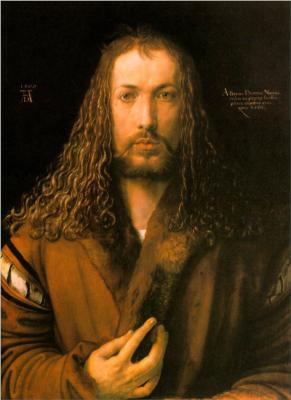Albrecht Dürer on Humanism
Who is Albrecht Dürer?
 |
| Self Portrait Albrecht Durer 1500 |
( Cunningham 336 )
The Work in Germany and Italy
Though Albrecht Durer's works were influenced by the contemporaries of the Renaissance in Italy, Durer had his own unique skill that transpire from his origins in Germany. " Durer's vision was enriched but not profoundly changed by his two journeys to Italy. Yet Durer did not just copy his strong, Southern impressions, but translated them boldly into his own Gothic and German dialect." ( Deuchler 5 ) However that Durer had his own distinct German influence on his work, it created a greater impact on his work between both worlds. For instance, the Apocalypse series was created with 15 woodcuts with engravings that are linearly precise cuts. The importance of the art is to promote German art into higher positions with artistic skills in Europe. Also, the vibrant of his linear cuts were suddenly judged by being too fine and dim. This didn't stop Durer from continuing his work with the balance between Italy's and Germany's contemporaries.
| The Four Horsemen, from The Apocalypse Albrecht Durer 1498 Germany |
Durer's Humanism Influence
In connection to humanism, humanism can be taken as an achievement that has been done by a human through their own personal thoughts and theories. In particular, we can take Durer and his work on "linear perspective". Durer coming from Germany and encountering this in Italy has changed his whole perspective in his works of art. Durer took this idea and balanced it within his own German-style art with Gothic spirit and Renaissance oriented. In addition, " he did not abandon his new interest in philosophy and natural science but began to study mathematics... and became a member of the Humanist circle..." ( Deuchler 6 ) Durer did study mathematics but it used to help him figure the precise proportions for the human body. He wrote The Four Books on Human Proportions that focuses on the idea that artists shouldn't focus on a single type of body (the female body that is typically half-dressed with sorrow expressions). He goes deep in details on how it should be further modified and expanded to various types of bodies with precise measurements of them. Durer encountering "linear perspective" furthers him into expanding the humanistic values of the human body with arts.
" Exhibition: The Young Dürer: Drawing the Figure " gives a deeper insight into who Albrecht Durer is and how his work through precision has developed over the years.
Work Cited
Cunningham, Lawrence, et al. Culture & Values a Survey of the Humanities. Cengage Learning, 2018.
Deuchler, Florens. “ALBRECHT DÜRER.” The Print Collector’s Newsletter, vol. 2, no. 1, Art in Print Review, 1971, pp. 4–5, http://www.jstor.org/stable/44130079.
Parshall, Peter. “Graphic Knowledge: Albrecht Dürer and the Imagination.” The Art Bulletin, vol. 95, no. 3, [Taylor & Francis, Ltd., CAA], 2013, pp. 393–410, http://www.jstor.org/stable/43188839.
The Courtauld. " Exhibition: The Young Dürer: Drawing the Figure. " Youtube. 13 Nov. 2013, https://www.youtube.com/watch?v=Jp8z-QA9LUQ&t=107s
Comments
Post a Comment